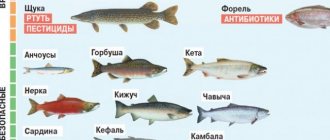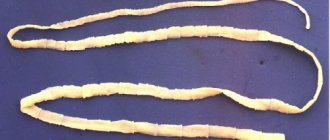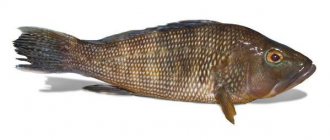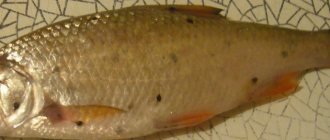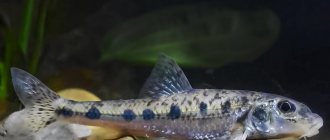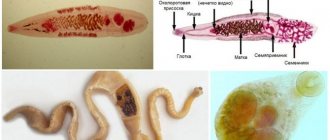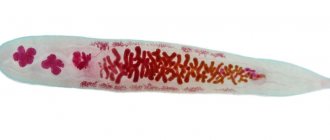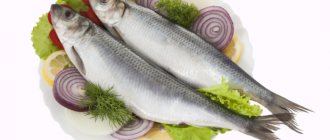Can there be worms in pink salmon, chum salmon, salmon and other red fish?
Currently, delicious dishes made from red fish, such as salmon, trout, pink salmon, and chum salmon, are very popular. Preference is given to culinary products made from raw or half-raw fish with minimal use of salt and heat treatment (sushi, fresh fish salads). Gourmets claim that this way the natural taste and nutrients of the product are preserved. As a gift for such delicacies made from red fish, for example, pink salmon, you can also purchase their natural inhabitants - worms. You may not even suspect that the infection with worms came from pink salmon, salmon, and chum salmon, because the manifestations of the diseases are nonspecific. They can manifest as skin rashes, digestive disorders and other symptoms.
What worms are in red fish?
The causative agents of helminthiasis are the larvae of flat and round worms, which are present in almost all types of industrial fish, including chum salmon, pink salmon, salmon, and trout.
Diphyllobothriasis is a helminthic infestation caused by the broad tapeworm. In red fish, such as salmon, trout, chum salmon, pink salmon, helminth larvae are located in capsules - thin translucent shells that look like grains of rice (pictured above). They are located in the gastrointestinal tract, in caviar, milk, liver and muscles. When the capsule is destroyed, the parasites enter the fish's body. They appear white or milky in color, up to 55 mm long and up to 3 mm wide.
When they penetrate the human body, the larvae grow into a parasite up to 12 meters or more in length. It can live in the body for up to 15 years, causing poisoning with varying intensity. The main signs of the disease are weakness, frequent headaches, loss of appetite, nausea and vomiting, heartburn, belching, stool disorders. An itchy skin rash may also appear. The most common infection with the larvae of these worms is observed in pink salmon and chum salmon.
Nanophyetosis is a helminthiasis that can affect pink salmon, chum salmon, trout, and salmon. The larvae of this group of parasites are resistant to treatment - in the refrigerator at a temperature of 4°C they remain viable for 15-16 days, in boiling water they die after 2 minutes, and when salted they die in 3-5 days. Upon penetration into the human body, they cause severe diarrhea, and in chronic cases, anemia.
Anisakiasis is a helminthiasis caused by roundworms. Almost all types of marine fish are infected with the larvae of these parasites. Red fish are no exception - pink salmon, trout, chum salmon. The most infected with these worms is chum salmon, followed by pink salmon and salmon. In the body of a fish, helminths are located in the liver, spleen, abdomen, gastrointestinal tract, milk and eggs, but most often in the muscles. The worms look like spirals of whitish, cream or brown color, about 2-5 cm long, up to 2 cm wide.
When entering the human body, anisakids can cause intestinal ulcers, as these worms penetrate the mucous wall of the stomach and intestines.
Is it possible to eat red fish with worms?
According to sanitary standards, red fish infected with the above worms is considered “conditionally suitable” for consumption, but it requires a special treatment regime that guarantees complete neutralization of the parasites.
To prevent infection with worms, you should not eat raw red fish. You need to fry it covered or in the oven at a temperature of 180-200°C, cook for 10-15 minutes in boiling water. Industrial preparation methods completely neutralize worm larvae. When frozen, the helminths of red fish (pink salmon) die at a temperature of –20°C within 2 days, in a freezer at –4°C – after 25-30 days, and when salted at home – no earlier than after 15 days.
The most common fish parasites
Recently, cases of detection of dangerous parasitic infestations among the inhabitants of water bodies have become more frequent. If several decades ago there were isolated cases of fish diseases caused by various helminths, today infected fish are being caught more and more often. Perhaps this is due to ecology and environmental pollution or something else, scientists have not yet come to a consensus. Be that as it may, the fish continues to get sick, and the most common parasites that infect it are the following:
- Eustrongylides, belonging to the genus of Dioctoform nematodes. Adults
Eustrongylides
parasitize in the stomachs of birds that feed on fish. They have intermediate hosts in the form of fish. The worm appears in the form of threads of red or red-white color, up to 50 mm long, located in fibrous cysts in the abdomen, in muscle tissue, in the stomach and intestines, as well as in the liver and testes. In cases where there are many larvae, they can lead to hyperemia and hardening of the stomach tissues in catfish, damage to the milk of perches, and cause kidney destruction in sturgeon. Infection with this type of parasite, when sufficient heat treatment is used, eliminates the danger for consumption and leaves the fish meat edible.
Philometra, a parasite that is a long, red, thin worm,
Philometra
parasitic in the body of a fish in the area of fins and head. Any inhabitants of water bodies, such as carp, bream, carp, crucian carp, perch, and pike, are susceptible to infection that causes the disease phylometroidosis. As it develops, at the beginning of the summer period, a fertilized, sexually mature individual releases more than 200 thousand of its larvae into the surrounding waters. They feed on crustaceans, which, in turn, are swallowed by fish. The larvae of worms enter the intestines of fish, and from there into all their internal organs, where they continue their development. Infection with this type of worms that live in the body of fish is not dangerous to humans, but the fish suffer significantly from their presence, becoming inactive. Fish meat, due to toxins released by the vital processes of parasites, becomes tasteless and unsuitable for consumption.
Parasites from fish
Experts say that almost all river fish have parasites in their bodies. For sea fish this figure is lower, but it also contains worms of different types. In Japan, where the national cuisine includes dishes made from raw fish fillets, the percentage of helminth infection among the population is very high.
The exception is sturgeon. They do not contain worms that could live in the human body.
The most common fish helminth is tapeworm.
Fish parasites that are found in the human body more often than others are listed in the table.
| Disease | Description of which fish contain parasites |
| Clonorchiasis | The causative agent of the disease is the Chinese fluke. The species is distributed in eastern Asia and the Amur River basin. The disease affects the lungs, liver and entire gastrointestinal tract. |
| Opisthorchiasis | Infection with cat fluke most often occurs due to fish from the carp family. Both people and animals can get sick. |
| Metagonimiasis | The disease is caused by a parasitic flatworm. Treatment is carried out in the hospital using such agents as naphthamon and male fern extract. |
| Nanophyetosis | Infection is possible from pink salmon, salmon, trout, and chum salmon. The parasite dies in 2 minutes of boiling and 3–5 days of salting. In humans, these parasites cause diarrhea and anemia. |
| Anisakidosis | Infection with these parasites is common in chum salmon and pink salmon. Helminths live in the muscles, liver, abdomen, spleen, milk and eggs of fish. |
| Diphyllobothriasis | The disease is caused by the broad tapeworm. In fish, the parasite is often found in capsules. In the human body, an adult worm grows from the capsule. |
Worms in fish
They parasitize the gills and body surface of fish.
Trematodes are helminth infections of fish, the causative agents of which are digenetic flukes, which in the adult state parasitize the intestines, organs of the excretory and circulatory systems of the definitive hosts - piscivorous fish. Their larvae, cercariae and metacercariae are localized in the tissues and cavities of fish.
The trematode Crepidostomum farionis infects juvenile salmonids (Identifier of parasites, 1987).
Cyathocephalus truncatus is a cestode. In inland waters of Kamchatka they are found in the pyloric region and in the intestines of juvenile sockeye salmon, chinook salmon and coho salmon. They are found everywhere within the range of salmonids from the Kola Peninsula to Kamchatka. In case of mass infection in fish farms, they cause the death of fish.
Diagnostics
Most diseases can have both acute and chronic forms. The acute course of the disease develops shortly after infection. It can be characterized by high fever, pain in the stomach, intestines and other organs.
Some parasites do not cause significant discomfort to humans, and you can only find out about them by taking tests.
Diagnosis of helminthiasis in both children and adults is the task of a parasitologist. You should contact him if you suspect worms. The specialist issues referrals for tests, based on the results of which he draws up a treatment plan. Some parasites are dangerous to humans and are resistant to mild drugs. Hospitalization may be required to get rid of them safely.
Red helminths in cats and dogs
Ascariasis in cats
In cats, roundworms cause toxocariasis. Infection occurs through the transmission of eggs from other infected cats through environmental objects. Sometimes the eggs are even located on the fur. Possible intrauterine infection during childbirth. The disease is most severe in kittens under 3 months of age. A sick cat can also infect humans.
Symptoms are most pronounced in kittens.
These include vomiting, fever, pale mucous membranes, dull and dry fur, itching of the anus (the cat may constantly lick it or fidget on the floor).
Ascariasis in dogs
The disease is called toxocariasis. Most often, puppies suffer from the disease, which is quite dangerous. The worms can form a tight ball, which can lead to intestinal rupture, which can be fatal. Worms are not so scary for adult dogs, but they do have their negative impact, albeit slowly. A person can become infected with ascariasis from a dog.
Symptoms: loss of appetite, exhaustion, weakness, puppies have a swollen belly, paleness, dry and dull hair, an infected dog can ride on its butt.
Hookworm disease in cats
Parasites usually do not cause serious consequences. Infection often occurs due to violation of animal husbandry standards and high overcrowding. Infection can occur through the skin, by eating food, and also in utero. Hookworm leads to the development of anemia, and the toxins released by the parasite negatively affect the animal’s body. Symptoms are clearly manifested only in kittens: weakness, anemia, vomiting, diarrhea.
Hookworm in dogs
The parasite enters the animal's body through the skin or through food. Intrauterine infection is possible, and parasites are detected only on the 15th day after birth. Symptoms: urticaria at the sites of parasite penetration, bleeding wounds in the intestines, anemia, swelling, weakness, exhaustion.
Red parasites include roundworms and hookworms, which affect both humans and domestic animals.
In this case, mutual infection may occur. Symptoms are not always pronounced; in animals they appear only in the first months of life. Treatment of parasites is possible; for this it is necessary to undergo appropriate tests and select treatment. You can independently make an assumption about hookworm - parasites can be found in feces.
Prevention
Parasites from fish are more common in adults, since poorly processed foods are less common in children's diets.
You should avoid raw dishes with unknown fish, since their consumption leads to the appearance of parasites in the body.
You can eat raw fish without the risk of becoming infected with parasites if it:
- grown artificially (with artificial feed and health control);
- refers to sturgeon (sterlet and others);
- caught at sea, immediately frozen and thawed only before eating.
The basis for preventing human infection with worms from fish is its proper preparation. For cutting fish, it is advisable to have a separate board or wash it thoroughly with hot water and soap after finishing working with fish. Hands and kitchen tools should be washed thoroughly before contact with other products.
Cooking technology
To neutralize possible parasites, it is important to observe the fish processing time:
- cook for at least 15 - 20 minutes after the water boils;
- fry for at least 15 - 20 minutes;
- cook baked goods with fish filling for at least 30 minutes in the oven.
During cold or hot smoking, the parasites in the fish die by the time cooking is completed.
You can kill parasites by freezing:
- 12 hours – minus 27°C;
- 18 hours – minus 22°C;
- 36 hours – minus 16°C;
- 3 days – minus 12°C;
- 7 days – minus 8°C;
- 10 days – minus 4°C.
These figures are correct if the fish weighs less than 2 kg. If the weight exceeds this limit, it should be frozen longer.
Parasites and their larvae also die when fish is salted:
- after 5 – 9 days with hot salting;
- after 6 – 13 days with cold salting;
- after 9 – 13 days with dry salting of whole fish;
- after 7 - 12 days with dry salting of cut fish.
These numbers are correct if the amount of salt is at least 20% of the amount of fish.
Parasites in fish that are dangerous to humans
04.10.2018
There are many ways to become infected with parasites. One of the main ones is eating fish that has not undergone sufficient heat treatment. Parasites in fish are common: statistics say that approximately 90% of all fish living in fresh and sea water are affected by worms. Fans of dried, salted, smoked fish, as well as sushi and sashimi should know about this.
Perhaps almost everyone knows that eating raw fish is, to put it mildly, not good. But at the same time, few unenlightened people guess why exactly. The fact is that the vast majority of fish species are carriers of all kinds of parasites. This is due to the characteristics of their diet. Some of these parasites do not cause anything in humans, worse than heartburn, while others pose a direct threat to our health. We think it’s better to omit the details, but believe me, the consequences are not very pleasant.
There is an opinion that only lake and river fish suffer from parasites, while sea fish are supposedly fine. But this is just a myth that is completely refuted by modern research. Do not think that the situation is different with seafood grown on specialized farms. In fact, in the cramped tanks where marine life lives, parasites spread at a comical rate.
The main danger of fish infected with worms is that the worms living in the fish enter the human body and provoke the development of helminthiasis. Not all worms that infect fish can infect people. But it is important to realize which parasites are dangerous to humans, and in which types of fish they live. This will minimize the risk of invasion.
Tapeworm (tapeworm) – provokes the development of the disease diphyllobothriasis. It grows up to 12 m and lives in the human body for decades. This type of tapeworm affects pike, ruffe, perch, burbot, pike perch, and is sometimes found in salmon. Its larvae are quite large and white. They reach 5 mm in length and 3 mm in width. They are found in the muscles of fish, as well as in the internal organs. The number of larvae is very large, so they are easy to notice in raw fish during cutting. Fluke (feline and also Siberian) – provokes the development of opisthorchiasis. This parasite is relatively small in size - 8–13 mm, and affects the liver, gall bladder, its ducts, and pancreas. You can become infected by eating fish belonging to the carp family. This group includes rudd and carp, bream and roach, ide and dace, aspirant and tench. The danger is that fluke larvae are very small. A fish may look healthy, but its flesh contains thousands of parasite eggs. Trematodes are worms in fish that provoke the development of diseases such as nanophyetosis and metagonimiasis. The name of the fish in which trematodes can live is whitefish, chum salmon, Amur grayling, as well as malma, lenok, taimen, trout, Amur bream, carp, crucian carp. These worms settle in the small intestine of a person, causing enormous harm to health.
Anisakides – provoke the development of anisakidosis. These worms live in sea fish: herring, cod, salmon, and sea bass. In the body of the fish, these helminths curl into a spiral. Fans of Japanese cuisine, whose menu includes many raw fish dishes, are especially at risk of becoming infected with this parasite. These worms infect the gastrointestinal tract, causing the development of ulcers and other diseases.
All of these diseases lead to serious consequences. The gastrointestinal tract and the immune system are primarily affected. Helminths destroy internal organs and release toxins that poison the body. Also, parasites absorb the bulk of nutrients, which leads to depletion. This is especially dangerous for children. If they systematically do not receive enough vitamins, minerals and other beneficial substances, a lag in physical and mental development may begin. Given such harmful consequences, it is important to avoid eating fish affected by helminths.
The question arises, is it possible to eat fish with worms? Of course not! To prevent parasites from entering the human body, the caught specimen must be treated before consumption. Even if the meat is smoked and dried, this may not make sense. For example, in order for the herring worm to die, the fish must be properly salted, which is important, because the parasites in the herring are dangerous to humans.
Preventing fishworm infection simply by properly preparing and storing fish. And raw fish dishes can be eaten only under certain conditions:
— it must be artificially grown fish, fed with artificial feed, treated and monitored for the absence of parasites;
- if it is sea fish caught in the ocean, then it must be immediately frozen on a fishing vessel and thawed immediately before consumption; or it must be eaten immediately after catching;
— almost all types of river fish can contain parasites that are dangerous to humans (with the exception of sturgeon). Therefore, for example, sterlet can be eaten raw. And other types of fish must be salted, pickled or smoked in accordance with the developed recommendations.
Well-cooked or fried fish is safe. The rules apply to all fish, since it is impossible to distinguish by eye whether it contains microscopic larvae (which, once in the human body, will turn into adult worms).
The fish should be cooked for 15–20 minutes from the moment it boils.
Fry for at least 15–20 minutes (large fish is first cut along the ridge into a layer).
Bake fish pies for at least 30 minutes.
When hot smoking, the fish is completely rendered harmless by the time it is ready.
To minimize the risk of infection by parasites when eating fish, you should buy this product only in established retail outlets, where it undergoes mandatory control.
State Veterinary Medicine Service of the Lugansk People's Republic
Treatment
If the diagnosis shows the presence of helminths, the doctor draws up a treatment regimen. The dosage of drugs is selected individually.
Medicines for parasites are strong poisons, so the choice of drug and its dose should be left to specialists. The basis of therapy is medications, but in addition to them, a regimen and a special diet are important.
Tapeworm
Treatment for tapeworm is carried out only in a hospital. The drug is administered in three stages with breaks. Special agents are prescribed to protect the liver. There are both Russian and imported medicines for such parasites. German drugs are considered the most modern.
Standard treatment kills the helminth and removes it from the body. If intestinal obstruction occurs due to tapeworm, surgical intervention may be required. This situation occurs if there is more than one parasite or it is very large in size.
Opisthorchiasis
Diagnosis and treatment of opisthorchiasis are quite complex, since it can be asymptomatic in the human body for decades. The most effective drugs are Ecorsol and Populin. In some cases, Biltricide is prescribed.
Among folk remedies, aspen bark is the most popular, but it is advisable to use it under the supervision of a doctor.
Clonorchiasis
Modern diagnostics show this disease at almost any stage. In most cases, it is not possible to get rid of clonorchiasis without a professional approach. In addition to anti-parasite medications, other medications are also required:
- anti-inflammatory;
- antihistamines;
- antispasmodic;
- choleretic;
- sorbents.
An individually selected treatment regimen by a parasitologist gets rid of the parasite and smoothes out the consequences of its presence in the human body.
Metagonimiasis
The disease is treated with Biltricide, Cesol, Cysticide and other anti-helminth drugs. In the human body, the parasite can infect the heart, small intestine, and even the spinal cord and brain. Timely treatment helps to avoid serious complications.
Nanophyetosis
The disease is treated with Biltricide or similar drugs. The patient is prescribed table No. 5, as well as choleretic and antispasmodic medications. Additionally, drugs are selected to protect the liver. Treatment with the main drug is carried out in 1-3 doses.
Anisakidosis
The disease has long been considered harmless, since parasites cannot develop into adults in the human body. Recent studies have shown that the larvae cause great harm to health. If, due to anisakidosis, dangerous changes in internal organs appear, treatment is reduced to surgical intervention. In milder cases, therapy is carried out with drugs such as Mebendazole and Albendazole.
Poorly processed fish is a source of many parasites that can live in the human body. Timely diagnosis allows you to get rid of parasites in a short time and maintain the health of your internal organs.
Parasites in chum salmon
Today it has become fashionable to use as little salt, smoke and heat as possible when preparing fish (sushi, raw fish salad with vinegar and spices). According to fans, this preserves the natural taste of the product. And natural parasites, parasitologists add. Many people may not even realize that they are infected - the symptoms of the disease are very similar to allergies, diseases of the gastrointestinal tract and liver.
How can you get sick from fish? Here are the most common ones.
Opisthorchiasis.
The causative agent is the Siberian fluke. The size of the worms is 7–12 mm. parasitic in the gallbladder, bile ducts of the liver and pancreas. Along with humans, opisthorchis can parasitize many carnivorous animals: foxes, arctic foxes, sables, ferrets. The most common carriers of opisthorchiasis are cats. In addition to the named main hosts, two intermediate hosts participate in the development of the parasite, the first of which is the small freshwater mollusk bitinia, and the second is any fish from the carp family (ide, bream, dace, roach, tench, rudd, silver bream, podust, asp, carp ).
